Topics
Category
Era
Pelican Valley Navigation Company
Flowing out of Detroit Lake to the southwest, short segments of the Pelican River connect a string of five large lakes and two small ones. From 1889 to 1918, steamboats, launches, and a system of locks and channels connected this chain of lakes, which stretches twelve miles southwest from the town of Detroit Lakes.
In 1888, John K. West formed the Pelican Valley Navigation Company. The Pelican River flowed out of Detroit Lake one and a half miles southwest of the downtown dock. West’s company temporarily drained the river and dredged a one-mile channel that passed through a wide marsh called Muskrat Lake. At the eastern shore of Lake Sallie, West commissioned the construction of a dam and Dunton Locks, with a five-foot, eleven-inch drop. During the late nineteenth century, this was the location of the Dunton Locks resort, which included a hotel, cabins, and a nightclub.
Two miles across Lake Sallie was Shoreham, a small resort community. The Shoreham Hotel was located next to the boat dock. The maiden voyage of the steamboat Lady of the Lake reached the hotel on July 25, 1889. Although service was extended beyond that point in 1891, Shoreham was the primary destination of the Pelican Valley Navigation Company over the years. Boats negotiated the narrow, shallow S-curving channel of the Pelican River across a narrow isthmus into Lake Melissa, which was nine inches lower than Lake Sallie. Frequent dredging kept the channel open.
After crossing Lake Melissa, boats entered the next stretch of the Pelican River, which widened into a millpond behind the Bucks Mill dam. This remained the end point of navigation until 1908, when a lock with a twelve-foot drop was built. The Pelican River was dredged for more than a mile below the dam, and another lock—the Johnson—was built with a three-foot drop. From there, boats entered Little Pelican Lake and traveled to the Pelican Inn, on the southwest shore.
After crossing Little Pelican Lake, boats negotiated yet another channel before reaching Big Pelican Lake, the largest in the chain. It is unclear whether they traveled all the way to the lake’s west end, but apparently they served multiple points on the shoreline. Old maps show landings on the north shore.
The company carried passengers, freight, and mail. The normal schedule was three round trips from Detroit (the town’s name was changed to Detroit Lakes in 1926) to Shoreham, and reduced service beyond. The running time to Shoreham was one hour, and three hours to Big Pelican Lake. After the 1908 extension beyond Bucks Mill to Big Pelican Lake, two boats were in service. The somewhat larger Mayflower shuttled between Detroit and Shoreham, and the smaller Dakotah left Detroit at 8 a.m. for Pelican Lake. From there it made a midday shuttle trip to Shoreham, where it met the Mayflower’s second trip. Returning to Pelican Lake, its last trip of the day ran through to Detroit.
During its existence, the company operated a total of nine small, canopied launches. Passage through the locks limited their size; each launch seated between thirty-five and forty passengers. In about 1912, the steamboats Mayflower and Dakotah were replaced by the gasoline-powered Shoreham and Pelican, each operated by a single crew member
The growing popularity of the automobile reduced the number of passengers, forcing the Pelican Valley Navigation Company out of business in 1918. The boats were scuttled in Muskrat Lake, where they remain. During World War II, the sunken hulls were stripped of metal for military use. Other traces of the steamboat line are still visible. For example, Dunton Locks is now a county park, and the village of Shoreham is largely intact. The Bucks Mill dam still exists, and below it are the deteriorated concrete walls of the lock.
Bibliography
Isaacs, Aaron. “Steamboats, Locks and Canals near Detroit Lakes.” Minnegazette (Summer 1999): 21–34.
Related Resources
Primary
West, John K. Hotel Minnesota: Favorite Summer Resort of the Park Region. [Minnesota: s.n., 1889]
Secondary
Engstrom, Roger. “Pelican Valley Navigation Company.” Unpublished manuscript, Becker County Historical Society, Detroit Lakes
Hegg, Curtis. “The History of the Pelican Valley Navigation Company.” Unpublished manuscript, Becker County Historical Society, Detroit Lakes.
Sandvick, Sharon. “The Pelican Valley Navigation Company and Steamboats on Detroit Lake.” Unpublished manuscript, Becker County Historical Society, Detroit Lakes.
Wilcox, Alvin H. and Jessie Campbell West. A Pioneer History of Becker County, Minnesota. St. Paul: Pioneer Press Company, 1907.
Related Images
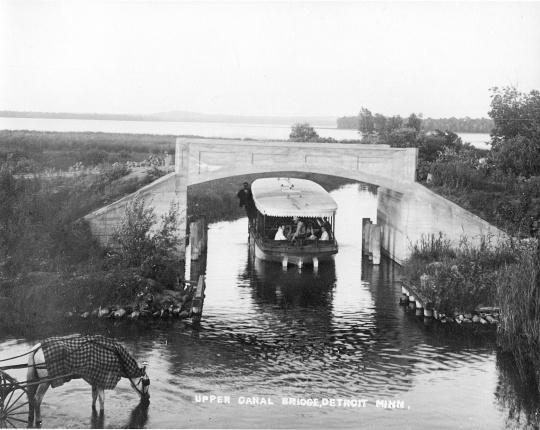
A steamboat on the Pelican River
Public domain
Holding Location
Articles
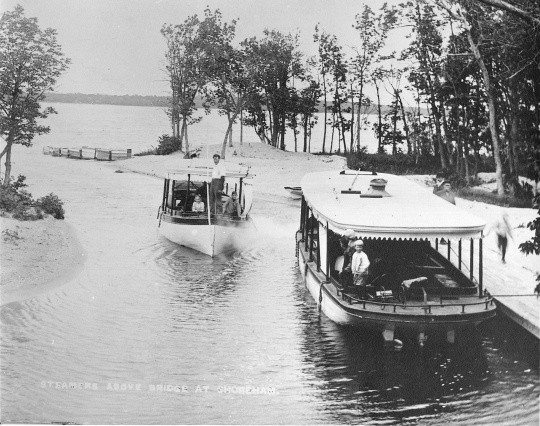
Steamboat on the Pelican River at Shoreham
Public domain
Holding Location
More Information
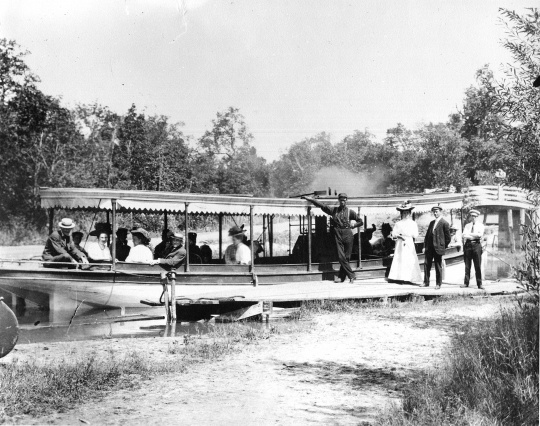
A steamboat docks at Shoreham
Public domain
Holding Location
Articles
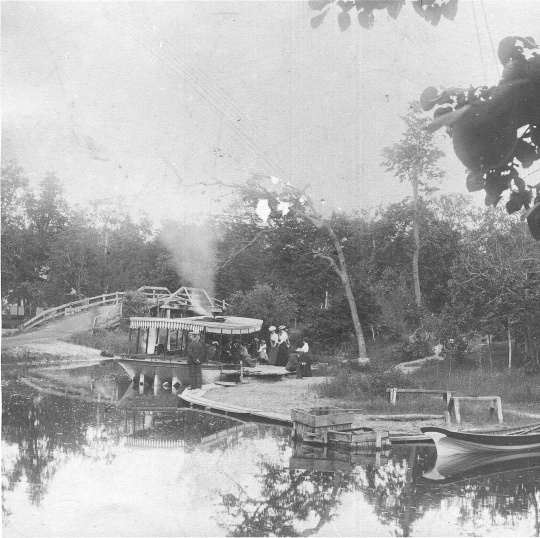
Steamboat at Shoreham dock
Public domain
Holding Location
Articles
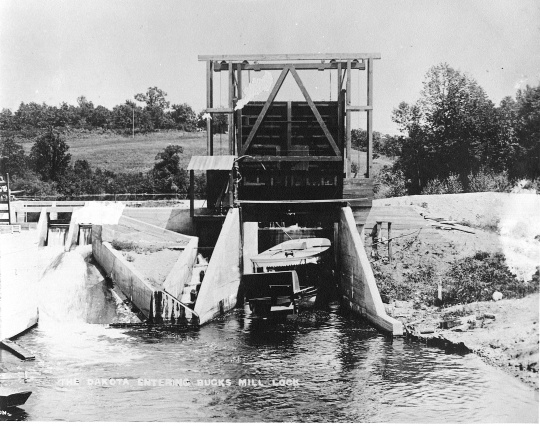
Steamboat at the locks at Bucks Mill
Public domain
Holding Location
Articles
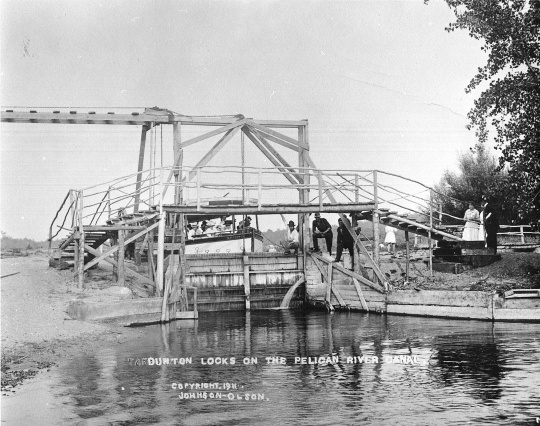
Steamboat on the Pelican River
Public domain
Holding Location
Articles
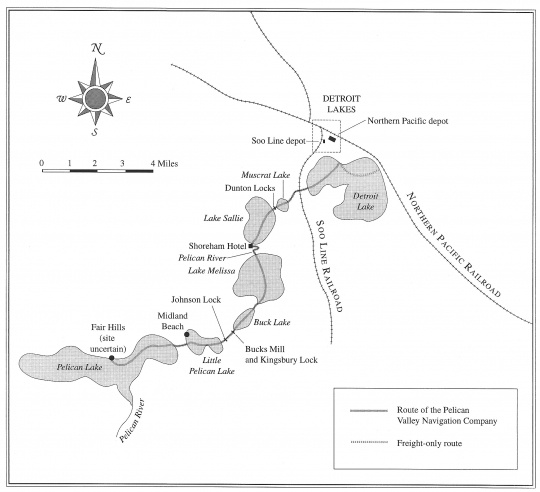
Pelican River Map
All rights reserved
Holding Location
Articles
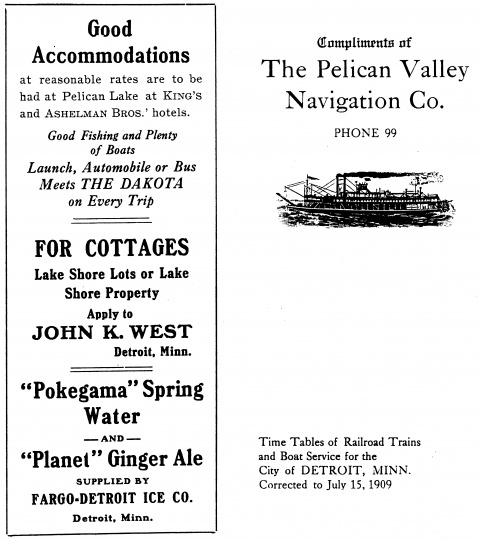
Pelican Valley Navigation Company Schedule
Public domain
Holding Location
Articles
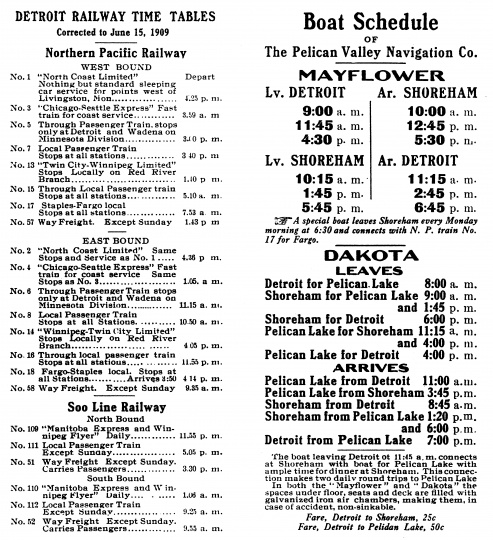
Pelican Valley Navigation Company Schedule
Public domain
Holding Location
Articles
Related Articles
Turning Point
In 1908, the Pelican Valley Navigation Company boat route is extended into Big Pelican Lake for the first time.
Chronology
1888
1889
1891
1908
1918
Bibliography
Isaacs, Aaron. “Steamboats, Locks and Canals near Detroit Lakes.” Minnegazette (Summer 1999): 21–34.
Related Resources
Primary
West, John K. Hotel Minnesota: Favorite Summer Resort of the Park Region. [Minnesota: s.n., 1889]
Secondary
Engstrom, Roger. “Pelican Valley Navigation Company.” Unpublished manuscript, Becker County Historical Society, Detroit Lakes
Hegg, Curtis. “The History of the Pelican Valley Navigation Company.” Unpublished manuscript, Becker County Historical Society, Detroit Lakes.
Sandvick, Sharon. “The Pelican Valley Navigation Company and Steamboats on Detroit Lake.” Unpublished manuscript, Becker County Historical Society, Detroit Lakes.
Wilcox, Alvin H. and Jessie Campbell West. A Pioneer History of Becker County, Minnesota. St. Paul: Pioneer Press Company, 1907.










